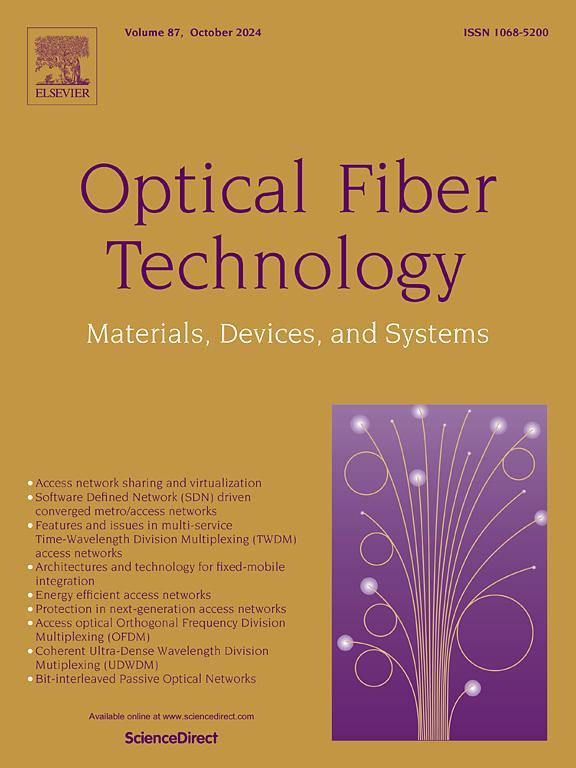具有远视选带和减小ISRS影响的多频带EONs频谱分配算法
IF 2.7
3区 计算机科学
Q2 ENGINEERING, ELECTRICAL & ELECTRONIC
引用次数: 0
摘要
多波段弹性光网络(mb - eon)已经成为一种有前途的解决方案,通过利用以前未充分利用的单芯光纤频谱带来扩展光传输系统的容量,从而解决全球互联网流量的指数增长问题。在本研究中,我们提出了一种路由、调制、频带和频谱分配(RMBSA)算法,该算法智能地集成了前瞻波段选择和带间受激拉曼散射(ISRS)影响减小频谱分配,以优化网络性能。远视选带规则采用主动选带的方法,优先选择支持的最大传输距离与当前路径所需距离之间差异最小的频段。该策略确保所选频带不仅满足即时传输需求,而且通过最小化不必要的调制降阶来保持长期的频谱效率。同时,ISRS减冲击频谱分配机制将频率片需求相似的连接请求分组,分配到各频段内连续的频谱区域,有效减少了频谱碎片化,提高了资源利用率。仿真结果表明,提出的RMBSA算法显著降低了阻塞概率,提高了频谱效率,提高了可容纳请求的平均光信噪比。该方法将前瞻性的频段选择与智能频谱分配相结合,为可扩展、高效的mb - eon部署提供了强大的框架。本文章由计算机程序翻译,如有差异,请以英文原文为准。
A spectrum allocation algorithm in multi-band EONs with farsighted band selection and ISRS impact reduction
Multi-band elastic optical networks (MB-EONs) have emerged as a promising solution to expand the capacity of optical transmission systems by exploiting previously underutilized spectral bands in single-core fibers, thereby addressing the exponential growth of global internet traffic. In this study, we propose a routing, modulation, band, and spectrum allocation (RMBSA) algorithm that intelligently integrates farsighted band selection and inter band stimulated raman scattering (ISRS) impact reduction spectrum allocation to optimize network performance. The farsighted band selection rule adopts a proactive approach by prioritizing bands with the smallest discrepancy between their maximum supported transmission distance and the current path’s required distance. This strategy ensures that the selected band not only meets immediate transmission demands but also maintains long-term spectral efficiency by minimizing unnecessary modulation downgrades. Meanwhile, the ISRS impact reduction spectrum allocation mechanism groups connection requests with similar frequency slices requirements and assigns them to contiguous spectral regions within each band, effectively reducing spectral fragmentation and improving resource utilization. Simulation results demonstrate that the proposed RMBSA algorithm significantly reduces blocking probability, enhances spectral efficiency, and improves the average optical signal-to-noise ratio of accommodated requests. By combining forward-looking band selection with intelligent spectrum allocation, this approach provides a robust framework for scalable and efficient MB-EONs deployment.
求助全文
通过发布文献求助,成功后即可免费获取论文全文。
去求助
来源期刊

Optical Fiber Technology
工程技术-电信学
CiteScore
4.80
自引率
11.10%
发文量
327
审稿时长
63 days
期刊介绍:
Innovations in optical fiber technology are revolutionizing world communications. Newly developed fiber amplifiers allow for direct transmission of high-speed signals over transcontinental distances without the need for electronic regeneration. Optical fibers find new applications in data processing. The impact of fiber materials, devices, and systems on communications in the coming decades will create an abundance of primary literature and the need for up-to-date reviews.
Optical Fiber Technology: Materials, Devices, and Systems is a new cutting-edge journal designed to fill a need in this rapidly evolving field for speedy publication of regular length papers. Both theoretical and experimental papers on fiber materials, devices, and system performance evaluation and measurements are eligible, with emphasis on practical applications.
 求助内容:
求助内容: 应助结果提醒方式:
应助结果提醒方式:


